Need to block the view of some nosy neighbours? Want a natural, green fence around your home? Or maybe you just love the look of tidy box hedges out front.
Fast-growing hedges can do wonders as screening plants, thanks to their bushy growth and evergreen leaves. Besides adding privacy, they can break wind and make great backdrops in gardens.
Hoping for some hedging in a hurry? Here are some of the best, fast-growing screening plants for Australian yards.
List of Fast-Growing Hedge Plants in Australia
- Aussie box
- Bottlebrush
- Boxleaf Honeysuckle
- Clumping bamboo
- Lilly pilly
- Magnolia ‘Little Gem’
- Murraya
- Photinia
- Viburnum
Before Growing Hedges: What to Consider
Whether you’re planning to grow hedges in the front yard or want some privacy ’round the back, here are some factors to consider:
- Soil type and drainage
- Available garden space
- Existing plants and structures
- Local climate and growing conditions
- Maintenance needs (e.g. watering or pruning)
You want to choose the type of hedge plant that is well-suited to your garden while matching your privacy needs!
Think about what you’ll grow around or underneath as well. Look for ground cover plants that can tolerate shade and have similar growing conditions.
If you have very limited space — or don’t have the ability to maintain full hedges — put up a fence or trellis for some fast-growing climbing plants. They establish themselves quickly, and many have large, dense foliage that provides privacy.
Best Fast-Growing Hedges for Australian Gardens
There are many fast-growing hedging plants that act as formal or informal screening in a yard. All these hedges are evergreen, so you’ll have a dense fence of greenery year-round.
Aussie box
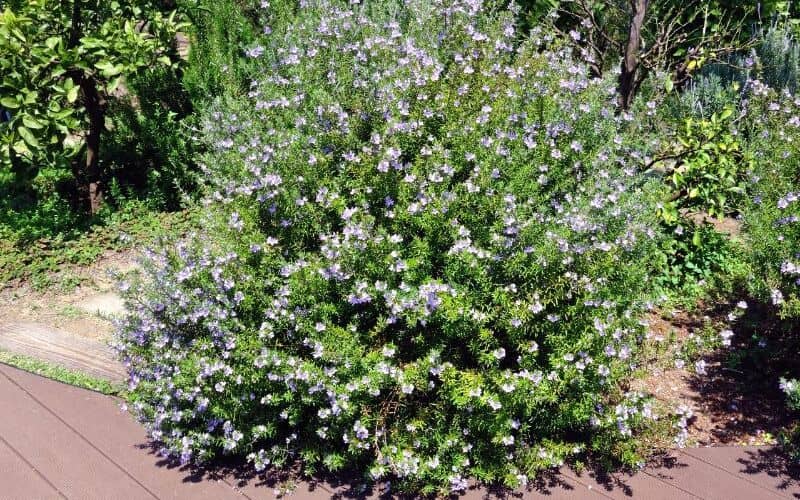
Size: Up to 1m height and width (without pruning)
Flowering: Spring to summer
Spacing: About 0.5m apart
Westringias are native Aussie flowering shrubs, and the Ozbreed Westringia hybrid Aussie Box is a perfect alternative to exotic box hedges. It doesn’t grow very tall, but it has a good, compact growth habit and dense foliage.
When left to grow unpruned, Aussie box has a round form, but it can be trimmed into a more traditional box shape. In the growing season, you’ll get pink or mauve flowers.
Aussie Box establishes quickly, and can tolerate drought, frost, and salt. Plant it in full sun with well-drained soil — Westringias don’t like wet feet!
Bottlebrush
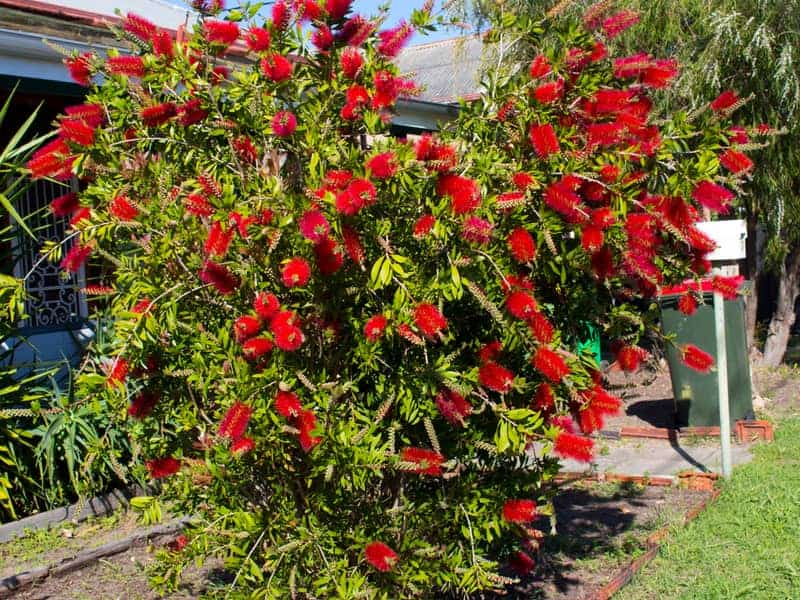
Size: Up to 3m height and width (without pruning)
Flowering: Spring to summer
Spacing: About 0.7–1.0m apart
The iconic Bottlebrushes (Callistemon spp.) are some of the best Australian native plants for hedges!
Bottlebrushes come as either small trees or large shrubs, depending on the variety. For tall screen hedges, look at varieties like ‘Kings Park Special’, ‘Wildfire’, or ‘Slim’.
These fast-growing screening plants can tolerate a wide range of conditions, including drought, part shade, and poor soils. Light pruning and deadheading will help keep bottlebrushes compact.
Keep in mind that bottlebrushes are susceptible to scale and sawfly larvae. For large infestations, you’ll need to contact a yard pest control service.
Boxleaf Honeysuckle
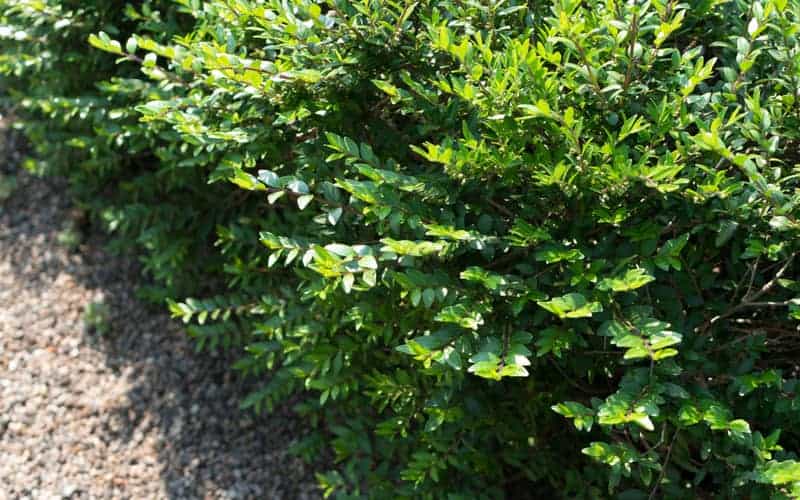
Size: Up to 2m height and width
Flowering: Spring
Spacing: About 0.6–1.0m apart
Spruce up your garden’s appearance with this fast-growing box hedge — the Boxleaf Honeysuckle (Lonicera nitida)!
The standard evergreen shrub has small, glossy green leaves and dense growth. Some cultivars have more colourful foliage, ranging from gold variegation to purple-bronze (in cold weather).
In spring, the plant puts out small, creamy-white flowers. These eventually give way to purple berries, which are not edible.
Boxleaf Honeysuckle prefers free-draining soil, and will tolerate shade and drought. Prune it regularly to encourage dense growth and maintain that traditional box shape!
Clumping bamboo
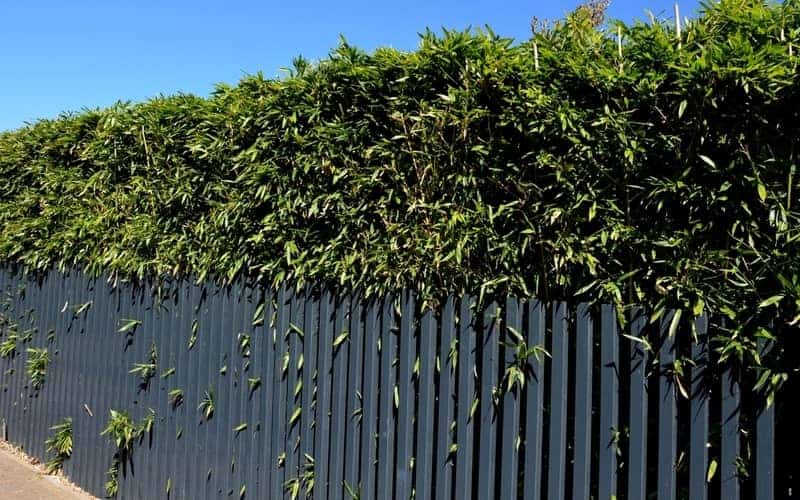
Size: Up to 3m height
Flowering: None
Spacing: About 1m between plants
Yes, bamboo actually makes a good, sustainable alternative to more traditional screening plants!
Look for clumping varieties in particular (like Japanese bamboo), as these only grow where they’re planted. Avoid running bamboo varieties, which can spread and become invasive.
Bamboo has many benefits as an informal privacy screen — it can reduce noise and act as a windbreak. Moreover, the narrow poles make it the perfect plant for small spaces.
Clumping bamboo is normally moderately drought- and frost-tolerant. It grows quickly and individual shoots reach mature height in a year (or less), but it can take up to 5 years to fully spread and establish a grove.
Lilly pilly
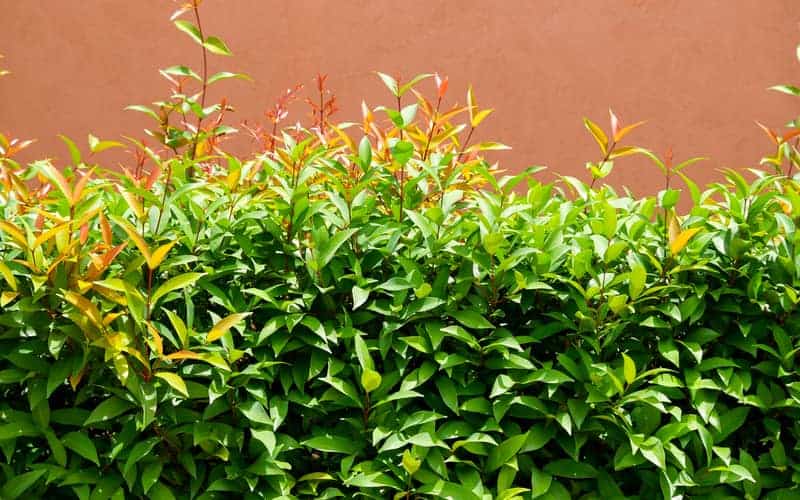
Size: Up to 5m height (for shrubs)
Flowering: Spring to summer
Spacing: About 0.6–0.8m apart
Lilly pilly varieties are among the best screening plants with non-invasive roots! They don’t penetrate very deep, but keep in mind that lilly pilly roots like to spread out, so they need lots of space underground.
These native shrubs make a practical, dense fence with their oval-shaped leaves. Many varieties produce edible fruits, including the popular Syzygium australe or bush cherry.
Lilly pillies are hardy and can grow in most climates besides very cold or arid ones. They prefer rich soils and full sun, but will tolerate part shade.
Be mindful of psyllid infestations with these hedges, though. If they’re available, look for psyllid-resistant cultivars, such as ‘Resilience’ or ‘Straight and Narrow’.
Magnolia ‘Little Gem’
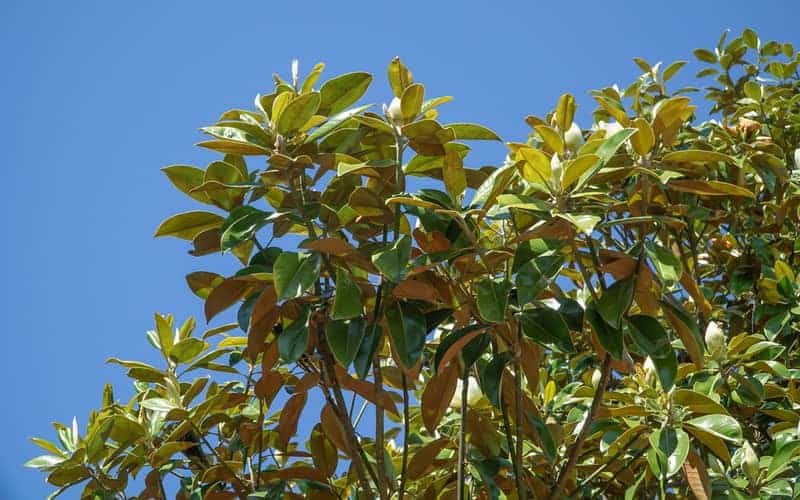
Size: Up to 4m height and 3m width
Flowering: Spring to summer
Spacing: About 1.0–1.2m apart
This magnolia cultivar is a popular hedge plant thanks to its adaptability, flowers, and leaf colour.
Magnolia grandiflora ‘Little Gem’ is a dwarf variety of the evergreen magnolia, a fast-growing tree. It reaches about 4.0m in height, and can tolerate partial shade, heat, and even frost.
The glossy, dark green leaves have an attractive bronze or rust-toned underside. In ideal conditions, you’ll get large white flowers in late spring to summer — or, in mild climates, intermittently year-round.
Magnolia ‘Little Gem’ likes rich, free-draining soil, and will flower more in full sun. Keep it well-watered in dry weather, as it’s sensitive to drought.
Murraya
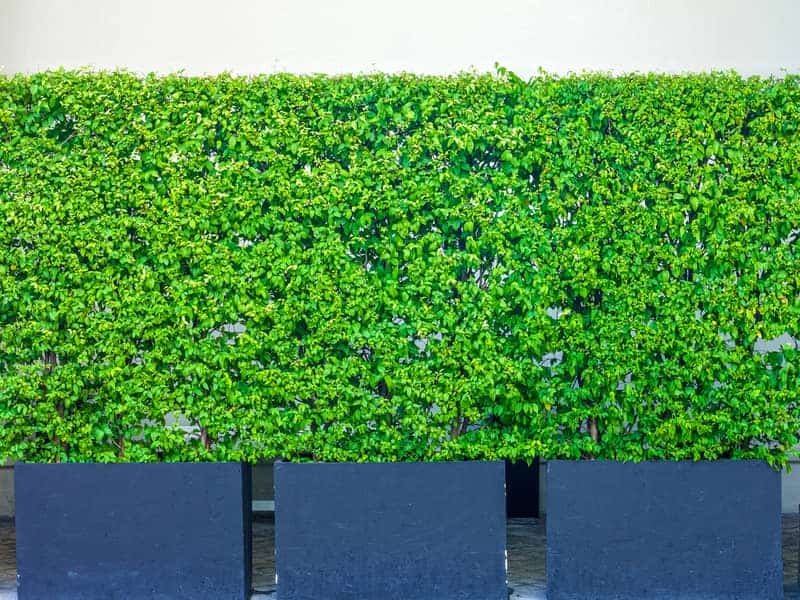
Size: Up to 4.0m height for mature plants
Flowering: Spring to summer
Spacing: About 0.5–0.8m (dwarf varieties) or 0.9–1.5m (full varieties) apart
If you’re in need of a quick-growing hedge for privacy and decoration, check out Murraya hedges. In late winter to spring, they have plenty of citrus-scented white flowers!
Double-check the hybrid or cultivar you choose, as some varieties (including the well-known Murraya paniculata ‘Exotica’) are considered invasive in NSW and QLD.
Consider the native mock orange (Murraya ovatifoliolata) as an alternative, or cultivars such as Sweet Privacy (Ozbreed) and ‘Min-a-Min’.
Murrayas thrive in rich, well-draining soil that’s slightly acidic, and in warm climates. Trim regularly in late autumn to early winter to maintain a good shape and encourage new growth.
Photinia
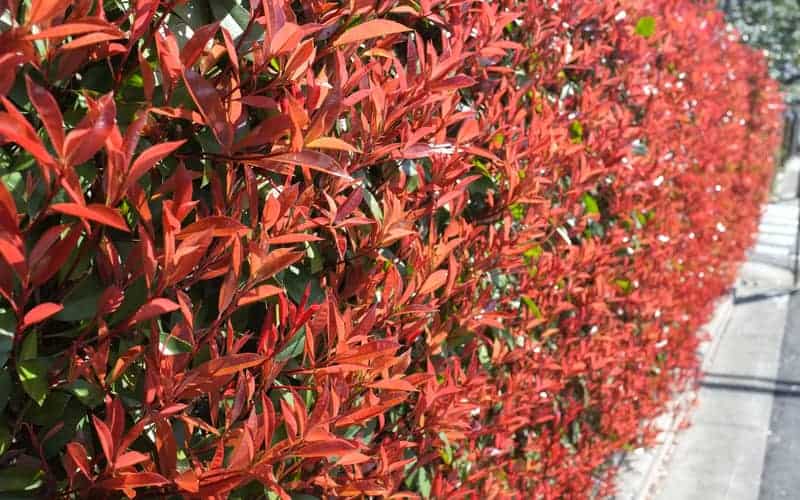
Size: Up to 5m height and 4m width
Flowering: Spring
Spacing: About 0.6–0.8m apart
Photinias have become very popular as hedges in Australia, and for good reason! The new growth comes in bright red, and mature plants can tolerate drought, frost, and wind.
Common varieties include Photinia robusta or ‘Red Robin’. For those with narrow spaces, consider ‘Thin Red’, which only grows 0.6m wide.
These hardy hedges like full sun and well-draining soil, but will be fine in light shade. They need regular watering while establishing, but mature plants can tolerate some neglect.
The small red fruits attract local wildlife, but are not edible for humans and may be toxic.
NOTE: Some people may be sensitive to the scent of photinia flowers and find them unpleasant!
Viburnum
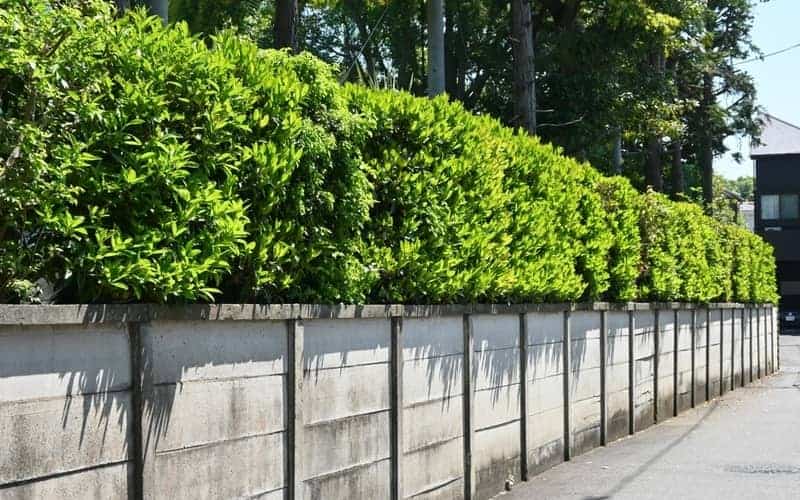
Size: Up to 4m height and width
Flowering: Late winter to spring
Spacing: About 0.5–0.9m apart
Viburnums are well-loved as fast-growing, evergreen hedges thanks to their dense leaf growth and low-maintenance needs.
For coastal areas or smaller spaces, consider Viburnum tinus (up to 2.5m), which has smaller leaves and white-pink flowers. Otherwise, you can’t go wrong with Sweet Viburnum (Viburnum odoratissimum)!
Viburnums are best suited to temperate and subtropical climates. They prefer lots of sun but can tolerate some shade, and some cultivars are cold-hardy down to -10ºC.
You can tip-prune new stems to encourage lush, new growth that branches out.
Tips for Garden Hedge Maintenance
To maximise your hedges, you’ll need to space them properly! The nursery or garden centre where you purchased the plants should tell you how far apart to position each one.
Proper spacing will ensure the most privacy without crowding the plants, which could stunt their growth.
Keep your hedges lush and well-shaped with routine pruning. If you need help, check out a reliable hedge trimming service in your area!
Follow proper care so your hedges stay healthy! That means knowing whether they need regular watering or are drought-tolerant, or whether they need fertilising (natives generally don’t).
Be mindful of pests and fungal diseases. Since these plants will be close together, it’s easy for an infestation or disease to spread — and you’ll likely need to get professional treatment.
FAQs About Hedge or Screening Plants
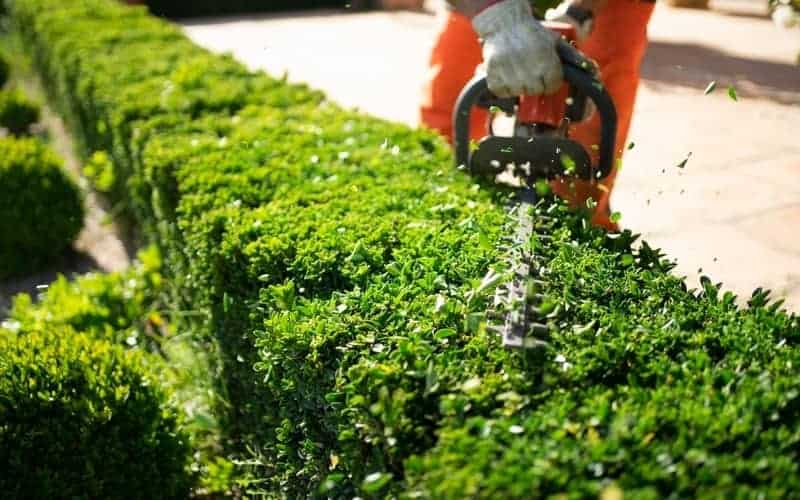
Here are a few more handy details to know about growing hedges!
What is the fastest-growing hedge in Australia?
Some very fast-growing hedge plants to grow in Australia include lilly pillies, murrayas, and viburnums!
Some lilly pilly varieties (such as Syzygiums) have a growth rate of 0.6m per year. Meanwhile, Murrayas can add up to 0.7m per year, depending on the cultivar.
For viburnums, Sweet Viburnum can add up to 0.6m yearly. The ‘Emerald Lustre’ cultivar has one of the fastest growth rates — up to 1m per year!
Just keep in mind that soil type, sunlight, climate, and other growing conditions can all affect how fast a plant can grow.
What is the quickest way to grow a hedge?
The quickest way to “grow” a hedge is to purchase more mature plants, so you’re not starting from scratch. However, this is typically more expensive.
Otherwise, it usually takes a fast-growing hedge up to 2–3 years to fully mature. Give the plant proper care and a good growing environment, and you’ll get bushy hedges soon enough!

